How a Desert Sparrow Inspired a Third-Year Medical
Student to Become a NASA Climate Informatics
Scientist Using High-End Computers
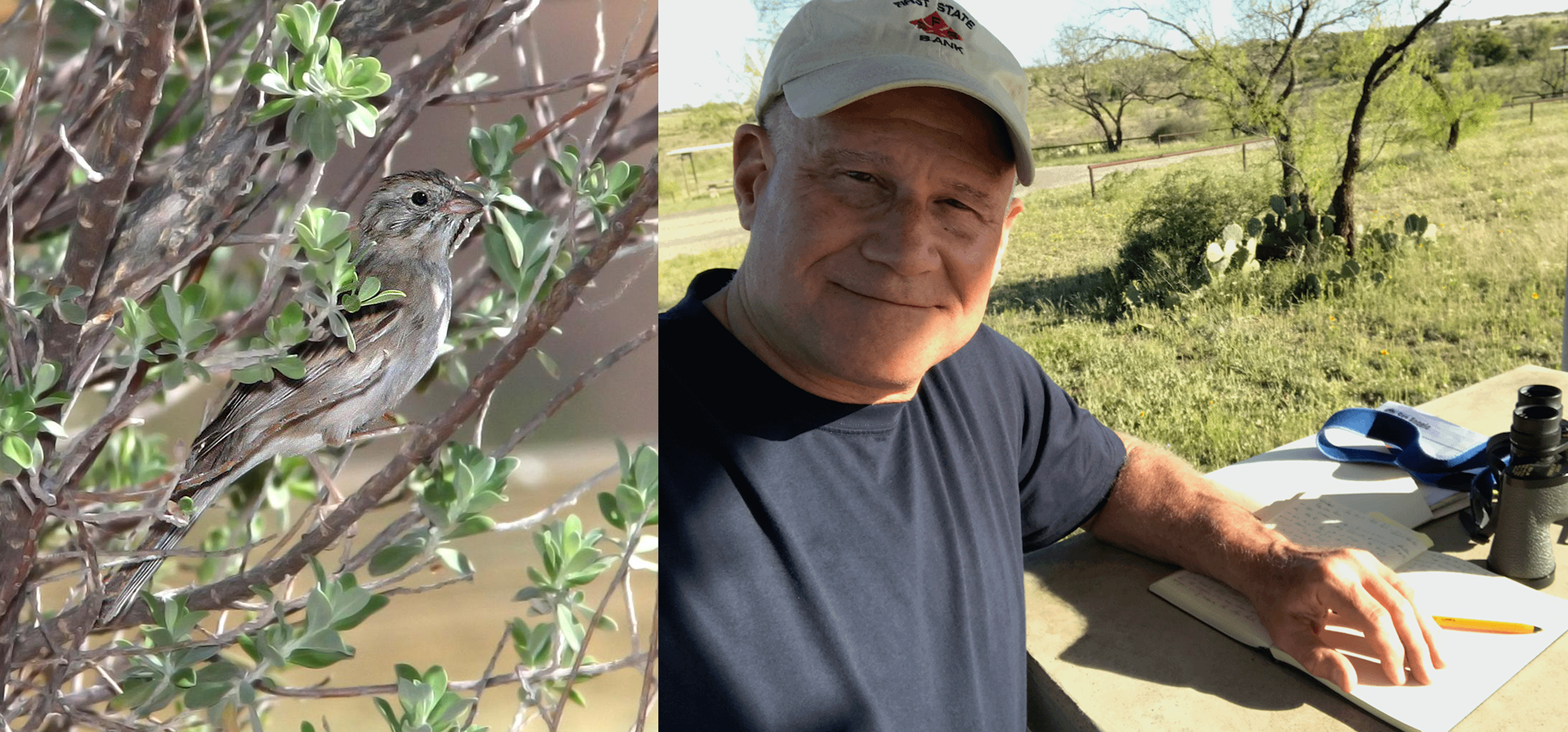
Left: Cassin’s Sparrow camouflaged in a shady bush in Patagonia, Arizona, on 27 April 2011. Photograph by Alan Schmierer via Flickr. Right: Dr. John Schnase conducting fieldwork in San Angelo, Texas, in 2020. NASA photo.
Meet NASA’s Emeritus Scientist, Dr. John Schnase, a deep-diving polymath who defies any single description or narrow category. Desert dweller. Biologist, wildlife ecologist, and computer scientist. Author. Innovator. Climate informatics scientist. Lifelong learner, teacher, and mentor.
“Polymath: an individual whose knowledge spans a substantial number of subjects, known to draw on complex bodies of knowledge to solve specific problems.”
Schnase, a self-proclaimed “high school science nerd,” was interested in “just about everything” – nature, history, biology, and science generally. These are hallmarks of a naturalist. His education took the winding path of a “curious, focus-challenged kid” who loved the desert and was inspired to learn more about its secretive residents. Starting out as a motivated biology major and then becoming an unsure, third-year medical student, Schnase eventually found his footing as a NASA climate informatics scientist who has used a unique combination of field observations, remotely sensed data, climate data, and computers to design information systems to enable a wide range of ecological and environmental research studies. He observed this fact about how his mind works, “The other side of having so many interests has been my ability to hyperfocus over long periods of time on things I am fascinated with. That has served me well in my studies.”
Schnase’s education and professional career took him from Texas in the 1980s to NASA Goddard Space Flight Center in Maryland in the late 1990s, after exploring a few side roads in between. In his 20 years at NASA, Schnase has made contributions to multiple fields of study that he integrated through his diverse background. Along the way, he also inspired, mentored, and positively influenced not only science but also many students and colleagues.
The stationary frame supporting the woven tapestry of Schnase’s path is the backdrop of the Chihuahuan Desert in West Texas, with multi-colored threads that he gathered from the diverse experiences and perspectives of an inspired naturalist and the honed tools of a multidisciplinary scientist, woven over and under that desert backdrop.
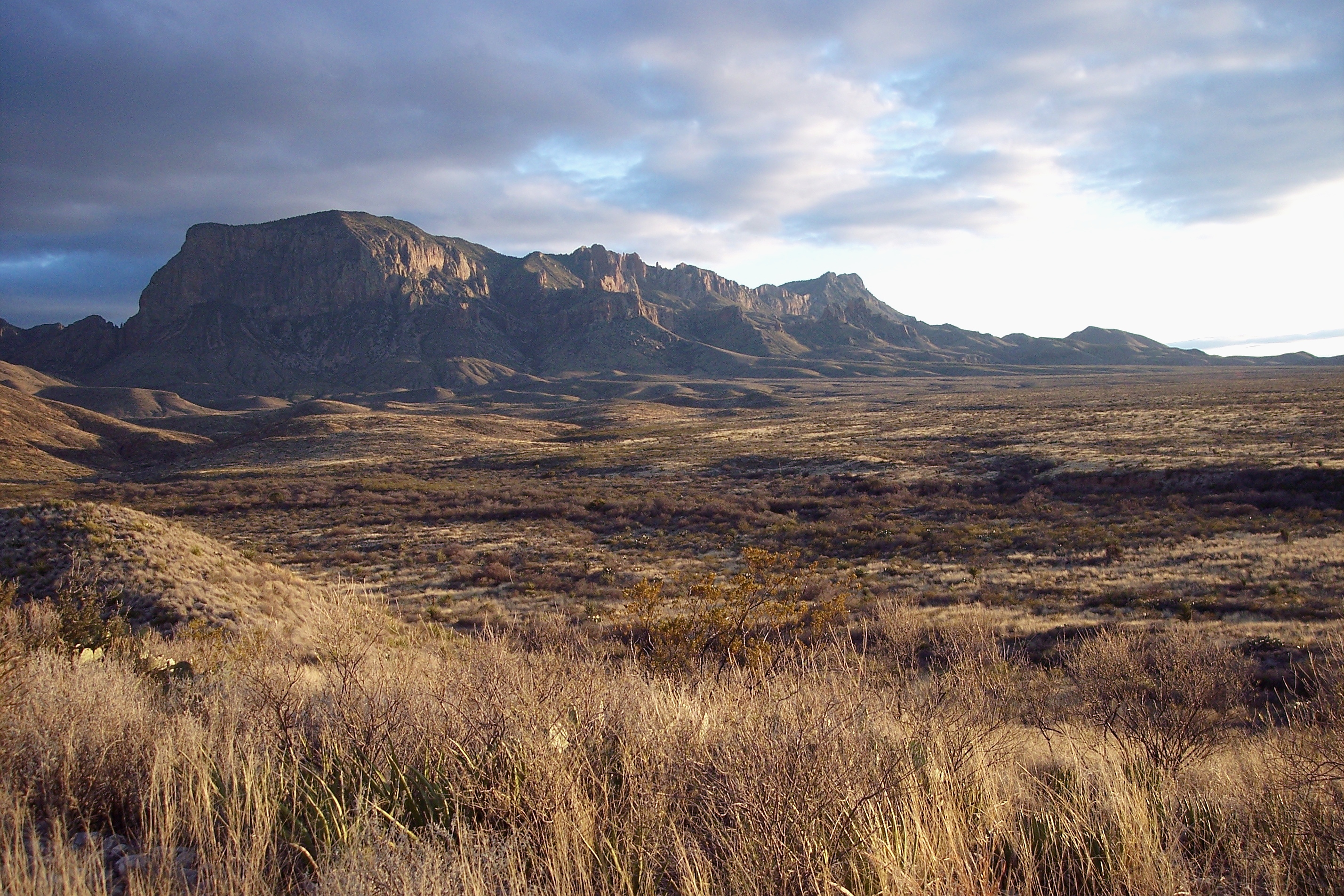
Above: A view of the Chihuahuan Desert in West Texas, John Schnase’s childhood “back yard.” Photograph by Adbar, CC BY-SA 3.0, via Wikimedia Commons.
The accordion button below reveals more detail of Schnase’s rich and varied career. Also below are a few thoughts from his colleagues about Schnase’s impact at NASA.
John Schnase grew up in Del Rio, Texas. His back yard was the Trans-Pecos (west of the Pecos River) area of the Chihuahuan Desert. As John describes Del Rio, “it’s located in West Texas, a little south of where the Rio Grande River crooks around in the big bend and then connects up through El Paso and Las Cruces with New Mexico.”
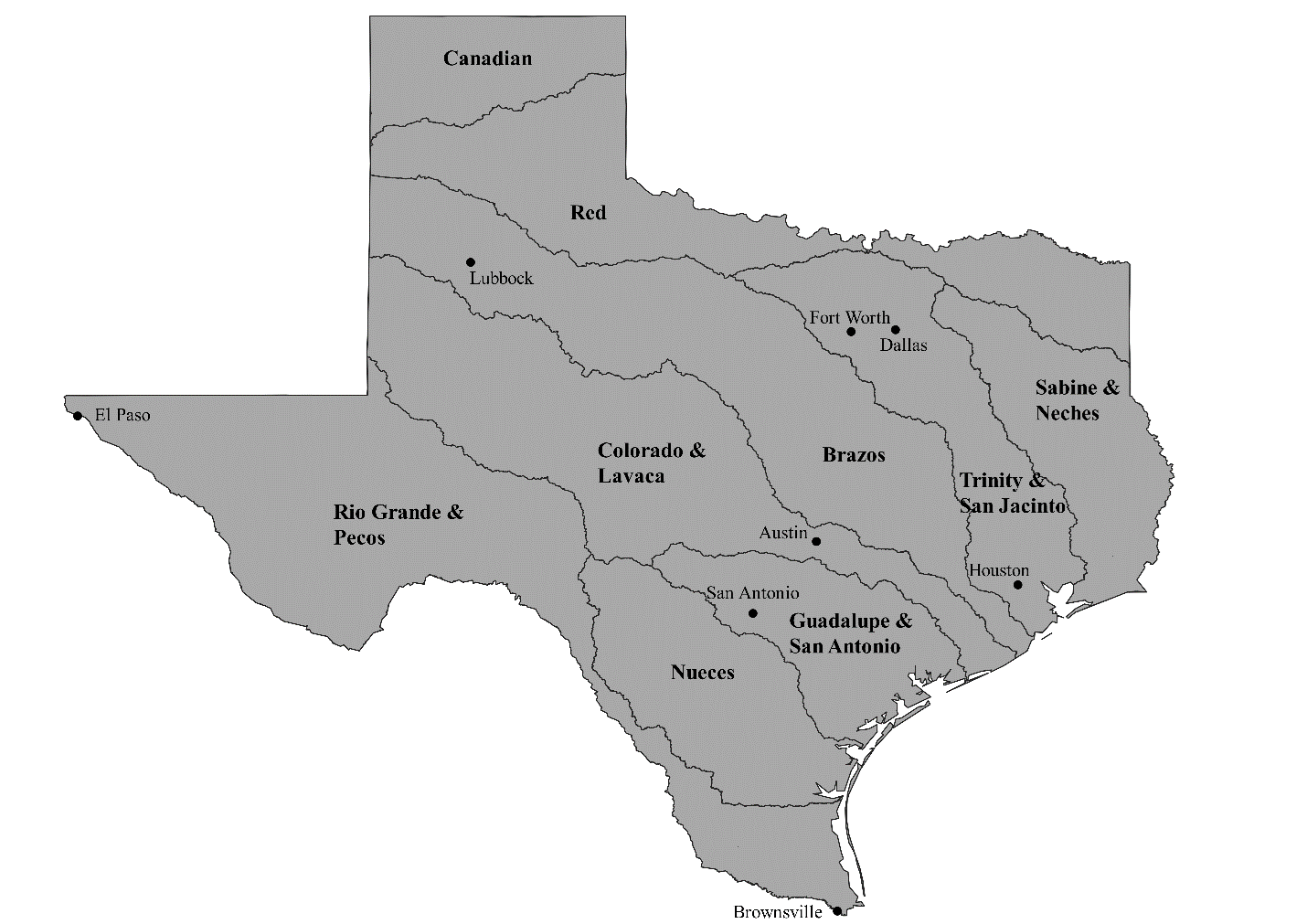
Above: A map of Texas river drainages, including the Rio Grande (Río Bravo del Norte), whose main course also forms the natural border between Texas and Mexico. Map by Cody Craig, Texas State University. Below: This map shows Del Rio, Texas, situated at the overlapping boundaries of the Chihuahuan Desert, the Texas border, and the Rio Grande. The Río Bravo originates in the rugged San Juan Range of the Colorado Rockies and flows south into the Gulf of Mexico at Brownsville, Texas. Satellite maps by Google.
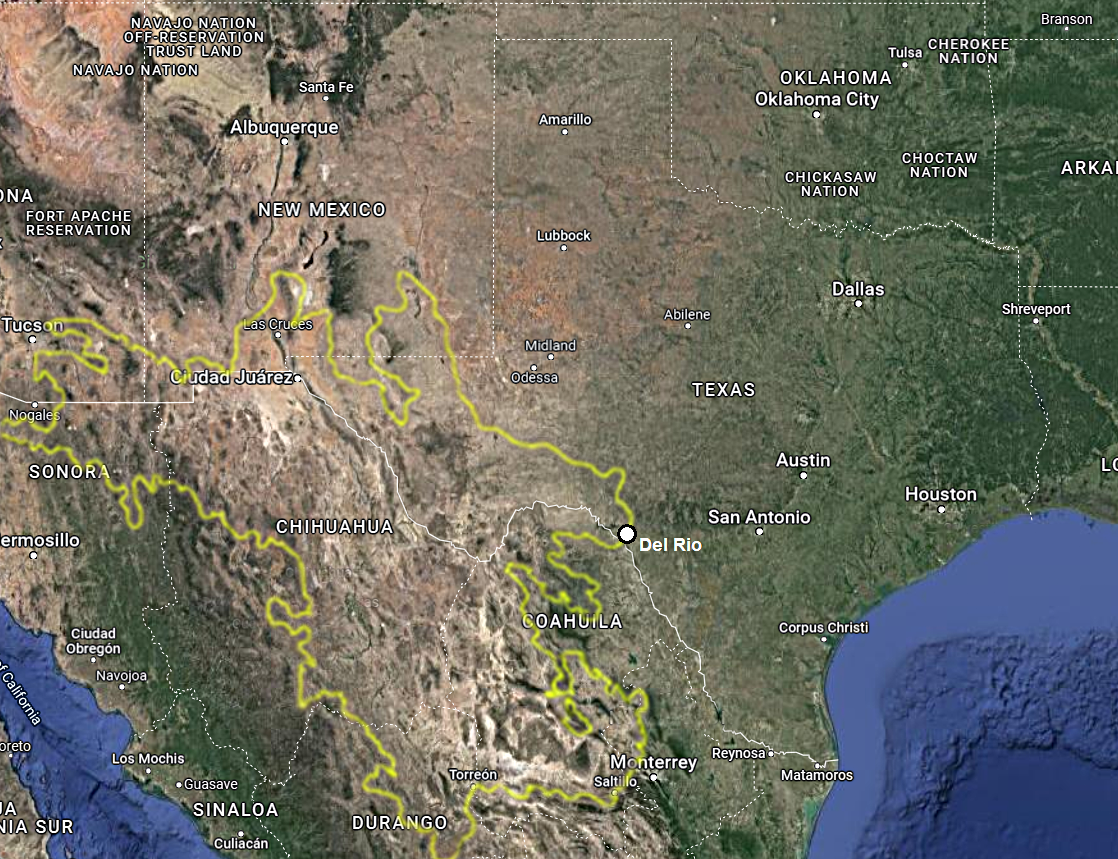
The town of Del Rio is located in Texas brush country – a semi-arid, mainly flat desert woven with canyons, springs, and river drainages and dotted with shrub and steppe vegetation, predominantly mesquite, acacias, and prickly-pear cactuses. This biologically diverse ecoregion of the Trans-Pecos is where Schnase first observed the elusive Cassin’s Sparrow as a child.
“Some of the earliest biological memories that I have,” he recalled, “were of personally discovering two or three critters in the desert that I just absolutely loved: horned lizards, roadrunners, and this really unusual sparrow. It's a small, grayish-brown, ground-dwelling sparrow. You don't even know this secretive bird is around until the breeding season, when the males have this remarkable skylarking display. They fly up from an exposed perch and sing a distinctive, 4-part melody, flutter their wings and tails mid-air, then fly down to the ground. A skylark display is very rare in North American bird species. I remember as a kid seeing these birds suddenly pop up all over from their hideouts in the brush and singing these beautiful songs.” Throughout his life, the primary source of Schnase’s inspiration and scientific curiosity continued to be this elusive, nomadic, desert-adapted sparrow.
Schnase has described the situation this way: “When people ask about my obsession with this little sparrow, I tell them that, throughout my life, this bird has been a personal guide of sorts, a helping hand, a quiet source of insight and wisdom. It inspired my interest in biology and drew me outdoors and into a sustained appreciation of the natural world. As strange as it might seem, it also drew me to computer science. Cassin’s Sparrow has helped me understand the complexities of ecosystem processes and human effects on those processes. This bird’s plaintive song and spectacular skylarks have been a constant source of solace and joy in my life. It’s my Sherpa bird.”
Schnase’s education and training as a scientist began in high school, when he immersed himself in special study programs over the summer at the University of Texas at Austin (UT), Texas A&M University, and M.D. Anderson Cancer Center. After high school, he studied biology for 3 years at UT. “I bounced around and took tons of courses, sat in on classes – just an energetic science nerd unleashed – and I had a blast.” Schnase took the Medical College Admission Test (MCAT) and, because he scored so high, along with his advanced training and education at universities during high school, he was accepted into medical school at Baylor College of Medicine in Houston, Texas without having to finish his undergraduate degree at UT.
About halfway through his clinical rotations at Baylor, Schnase realized that medical school wasn't a good fit. “I bounced out of medical school. He reflected, “At that point, I had been going to college for 6 years and had no degree. So, I decided to return to first principles and, it turns out, to that little sparrow that I sort of fell in love with as a kid.”
Not much was known about the natural history of Cassin’s Sparrow in the early 1980s, and Schnase wondered, “How many eggs does it lay? Where does it nest? Do both parents feed nestlings? What do they eat? How much? What is its distribution? Its behavior? That whole suite of things that defines the natural history of an organism was largely unknown at that time, because it is such a secretive species.” So, he went back to school to find out.
This time, Schnase chose a smaller college, Angelo State University in San Angelo, Texas, “one of the epicenters of Cassin’s Sparrow's range,” as he described that part of West Texas. He finished an undergraduate degree in biology, and his self-described obsession with trying to understand the mysterious bird's natural history by modeling their behaviors and their energetics using technology got him involved with using computers. “This whole business of me connecting birds and ecology and computer science got started there.” He continued on at Angelo State, earning a master’s degree in computer science. He started teaching computer science courses there as well, while working on his master's thesis on Cassin’s Sparrow. Schnase went on to complete a “dual Ph.D.” in computer science and wildlife ecology at Texas A&M University, 90 miles northwest of Houston. Before joining NASA in 1999, Dr. Schnase’s work on the life history of Cassin’s Sparrow (Aimophila cassinii) resulted in an early application of computers in avian energetics modeling.
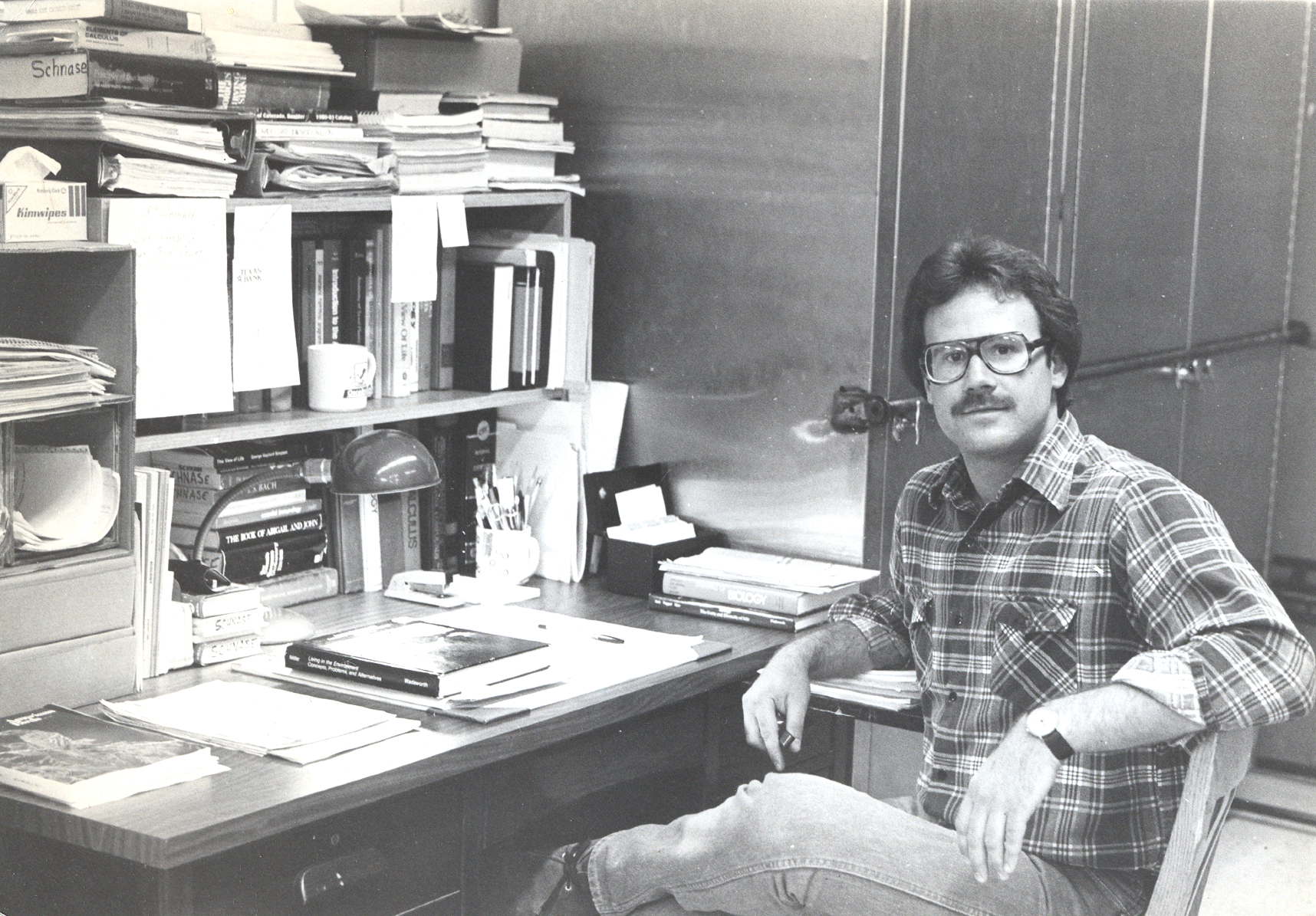
John Schnase in his office at San Angelo University in the 1980s, where he conducted a formal study of the Cassin’s Sparrow’s breeding biology and energetic ecology as a graduate student. NASA photo.
When asked how a desert-adapted sparrow got Schnase into using computers, he explained, “I've always connected hard-core computer science and computer modeling with ecological problems. Because of their basis in DNA, biological systems are computational systems. There is a natural affinity between the two fields, similar to what we see between music and mathematics. I've published a lot of computer science papers in my life, and most have the intellectual shelf life of unrefrigerated tuna salad. When you work with rapidly changing technologies, that’s just the way it is. On the other hand, the papers that I have written about Cassin’s Sparrow continue to be relevant, far and away get the most references, and are the most satisfying contributions that I feel I've made, modest as they are. [Editor’s note: Schnase has published over 100 scientific articles and has been referenced (to date) in another 500.]
“I guess the point of all this,” Schnase continued, “is that this little desert-dwelling bird has inspired my work from day one at NASA, and it continues to this day to drive a thread of technology and science research that is both very relevant and useful to studying climate change now. After all, birds – desert-adapted birds in particular – are among the most important harbingers of environmental disruption.”
After completing his Ph.D. at Texas A&M, Schnase went to work at the Washington University School of Medicine, helping establish a new research laboratory and serving as Director of the Advanced Technology Group at the school. He also became a Senior Research Associate in the Department of Computer Science at Washington University.
In his next career move, Schnase went to work at the Missouri Botanical Garden, one of the largest freestanding research organizations in the country, famous for its outstanding herbarium containing over 7 million unique specimens and plant data. There, Schnase became the Director of the Center for Botanical Informatics. He worked with the organization’s long-time president, Dr. Peter Raven, who became one of Schnase’s mentors.
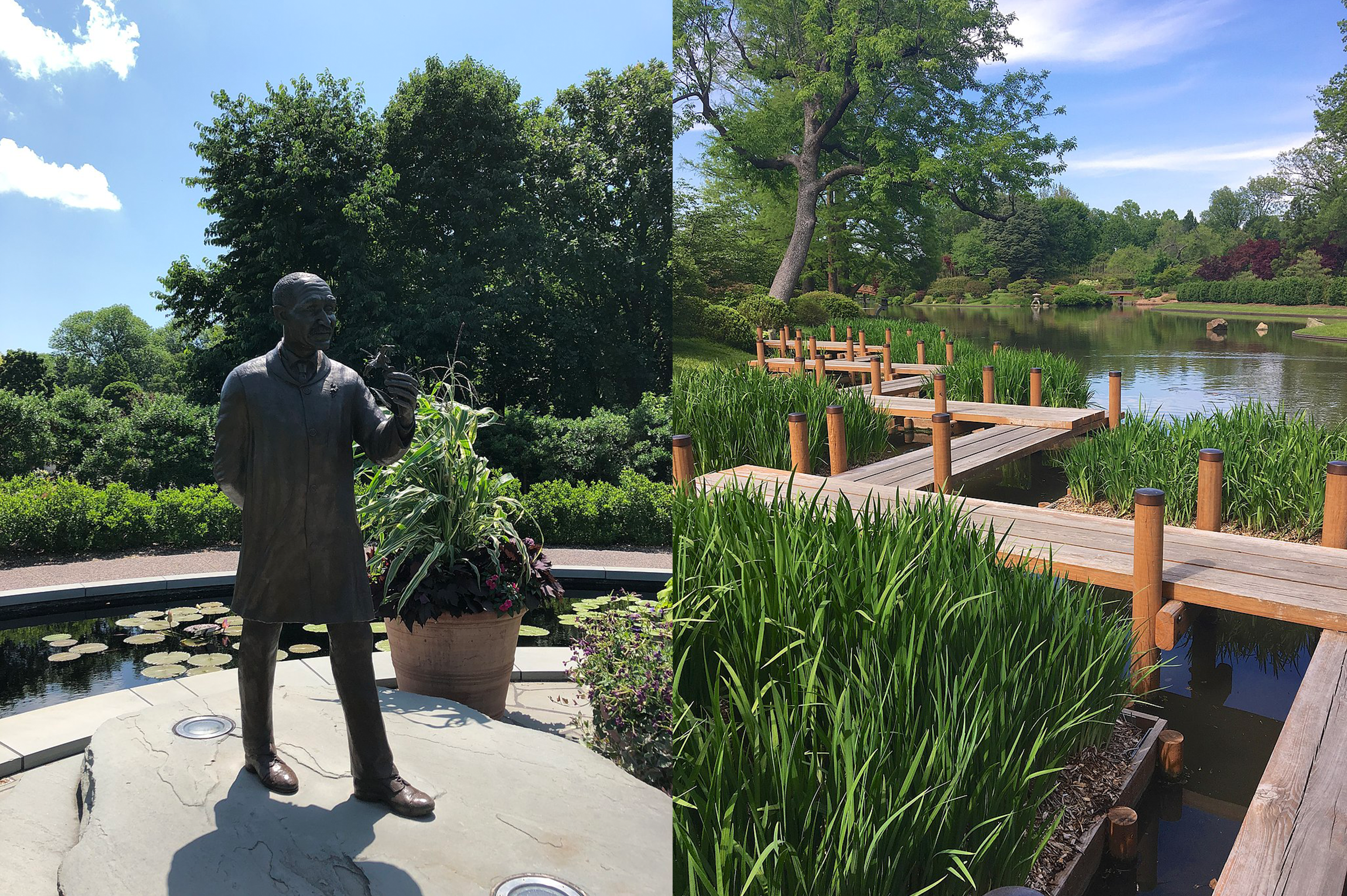
Images from the Missouri Botanical Garden. At left: A statue of scientist George Washington Carver, an innovative botanist and influential agriculturalist. Photograph by Paulmcdonald, CC BY-SA 4.0, via Wikimedia Commons. At right: A yatsu-hashi bridge (walkway over a pond) made of eight overlapping wooden planks in the Japanese Garden. Photograph by John Mackenzie Burke, CC BY-SA 4.0, via Wikimedia Commons.
Raven, an ecologist of note, grew the Missouri Botanical Garden to prominence as a research organization. At the time, Raven was General Secretary of the National Academy of Sciences (NAS) and the President's Council of Advisors on Science and Technology (PCAST). Schnase served with Raven on a PCAST committee on biodiversity and ecosystem informatics during the Clinton Administration, which brought the two colleagues from St. Louis to Washington, DC, every few weeks for formal PCAST committee meetings. NASA Administrator Dan Goldin attended one of the after-meeting socials, and Schnase discovered that he was also intrigued with the idea of mixing technology and biology. Golden had created some special hiring opportunities to bring in new NASA staff with multidisciplinary backgrounds in computer science, engineering, and biology. It was in that context that an opportunity to apply for a position at NASA opened up for Schnase. His unusual mix of seemingly unrelated fields became critical to working for NASA.
Schnase landed at NASA Goddard Space Flight Center in 1999, working at the Computational and Information Sciences and Technology Office (CISTO). He was hired by Dr. Milt Halem, the first of Schnase’s several important NASA mentors. At the time, Halem was Assistant Director for Information Sciences at NASA’s Goddard Space Flight Center. By that time, Halem’s office was situated next to the office of the NASA Goddard Center Director, Al Diaz. Schnase spent many of his early days at NASA Goddard working with Halem on several technology initiatives. It turned out to be a remarkable and most fortunate introduction to NASA and the agency’s many opportunities. Schnase’s early work at NASA Goddard focused on invasive species habitat suitability modeling. He served as Principal Investigator and Program Scientist for the Applied Sciences Program’s Invasive Species National Application. With help from Halem and a talented team of advisors, he served as the founding chair of NASA Goddard’s Information Science and Technology (IS&T) Colloquium.
More broadly, Schnase helped design computer systems that enable ecosystem research and used the high-end computers of CISTO’s NASA Center for Climate Simulation (NCCS) to make NASA’s Earth science data more accessible. Over the years, Schnase has received seven Software Release Awards from the NASA Inventions and Contributions Board and, along with his colleagues in CISTO, has obtained numerous patents for NASA that relate to high-performance computing and data analytics. He and his team were awarded NASA 2019 Invention of the Year Honorable Mention for their innovations in data analytics and data science. Schnase is a recipient of the Government Technology Leadership Award and the 2021 recipient of the NASA Strategic Partnership Office's James Kerley Award in recognition of his efforts to find commercial applications for NASA technologies. He is a Fellow of the American Association for the Advancement of Science (AAAS) and Past Chair of the Computing Accreditation Commission (CAC) of the Accreditation Board for Engineering and Technology (ABET).
Although he officially retired from NASA as a civil servant in late 2019, Schnase is continuing to pursue research threads that started when he was at NASA. Working closely with Dr. Mark Carroll, he is focusing on the Chihuahuan Desert and establishing collaborations with University of New Mexico and New Mexico Department of Game & Fish to help bring some of the technology and tools that he had a hand in developing at NASA – using NASA data and the outputs from NASA’s climate models, especially the MERRA reanalysis – to the modeling work that the state of New Mexico does on species of conservation concern.
Schnase’s research also includes fieldwork in the Chihuahuan Desert at the Sevilleta National Wildlife Refuge (NWR), located 20 miles north of Socorro, New Mexico. The Sevilleta NWR is also one of the National Science Foundation’s 28 Long-Term Ecological Research (LTER) sites that were selected for long-term studies of major ecosystem types and “to develop and test fundamental ecological theories and significantly advance understanding of the long-term dynamics of populations, communities, and ecosystems, often integrating multiple disciplines and, through cross-site interactions, examine patterns or processes over broad spatial scales.” The Sevilleta site (SEV LTER) is administered by the U.S. Fish and Wildlife Service.
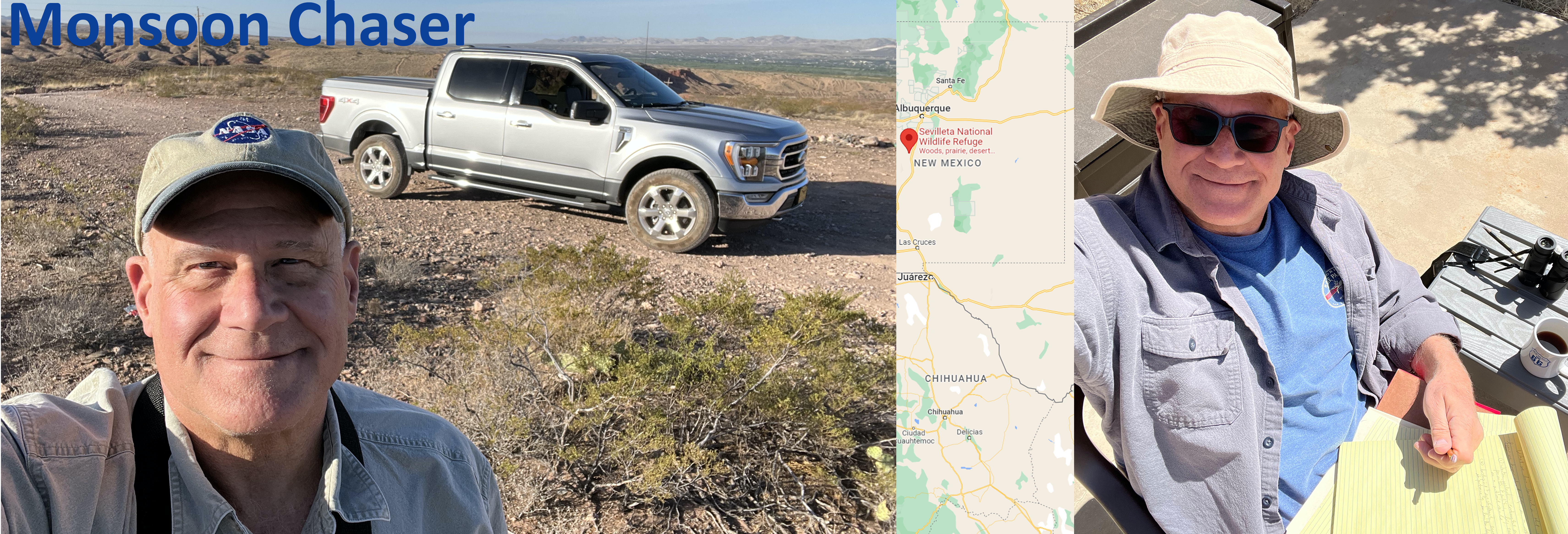
Left: John Schnase driving the North American Breeding Bird (BBS) survey routes in the Chihuahuan Desert of New Mexico in summer 2022. Right: Conducting fieldwork at the Sevilleta NWR near Socorro, New Mexico. NASA photos.
“This has really turned into a wonderful collaboration. It keeps me in contact with Mark and his advanced technology team and the science around endangered and threatened species modeling and conservation efforts,” Schnase remarked. “I'm retired from government service and only employed part time now as a consultant for NASA, but it's just absolutely delightful work and some of the most productive work ever.”
Schnase recently moved from Maryland to Santa Fe, New Mexico. As you can imagine, he’s happy to be back in the desert, permanently this time, studying the bird that has shaped his life while demonstrating NASA capabilities that can improve the lives of others.
“John Schnase has been a great mentor to me since I came to NASA Goddard in 2011. It was a chance meeting; my boss at the time had a conflict and sent me to cover a meeting with John about a project they had going. I had previous experience using high-performance computing (HPC) systems, so I was able to connect with the project on a technical level. I ended up taking the lead on that project and coming to regular meetings with John. After one such meeting, we were chatting, and he asked what else I was working on. It happened that I was just getting started on a project to generate decadal water masks for the newly funded Arctic-Boreal Vulnerability Experiment (ABoVE) Field Campaign. John asked how I was going to do all that processing, and I said I would rotate data through my local machine over the next 18 months. A few questions later, and he said they were just building a new system at CISTO (what would become ADAPT). He asked if I would I like to meet CISTO Chief Dan Duffy to see if we could run my project there. This all worked out and began a long relationship between ABoVE and CISTO.
This is one of many examples of John making connections between people, projects, and technology to advance science. John has a passion for advancing the use of climate analytics in various areas of science, but he is most passionate about birds. He has been studying the Cassin's Sparrow for over three decades in various capacities and now, in partial retirement, has been making a concerted effort to expand the use of climate analytics in species distribution models, with Cassin's Sparrow as the target species for development. Currently, he is networking with universities and state agencies in his new home state of New Mexico and has published two manuscripts on the topic in the past 18 months, with at least one more on the way.”
“When John Schnase joined NASA in 1999, he came in through a program designed to bring in top researchers to refresh NASA Goddard’s research capabilities. During most of my 40 years at NASA Goddard, we were operating under some kind of hiring freeze, but on occasion, the freeze would lift. When Milt Halem saw this opportunity, he moved very rapidly and was able to hire John.
John gave generous time to company business, taking on responsibilities that he didn’t have to, but that built up the organization. In 2000, he became the founding chair of NASA Goddard's Information Sciences and Technology (IS&T) Colloquium, elevating awareness of the center’s focus on information science on par with its established Engineering and Scientific Colloquia programs. He served in this role for several years and set a high standard that has sustained the IS&T Colloquium for 22 years.
John rapidly found NASA's pathways toward competitive research funding. In May 2001, John invited me to visit the headquarters of the US Geological Survey (USGS) in Reston, Virginia, and make a presentation at their workshop on internet supercomputing applications. I conducted a briefing on a NASA technology solicitation that I was preparing for release, one that would seek proposals from teams building software frameworks to facilitate models running on high-end computers. I was impressed by how enthusiastic my audience was and came to realize how well John had prepared them. They, with John as Principal Investigator, proposed, won, and carried out applied research using modeling to predict the spread of invasive species on federal parkland based on environmental data. John told me that 'the spread of invasive species is one of the most daunting environmental, economic, and human-health problems facing the U.S. and the world today.' During the several years of this research project, I was very impressed by the visibility that it had within the federal land management organizations.
John was really plugged in. I’m recalling 2011, when the National Academy of Sciences was holding hearings in Washington, DC, that would become their report, titled: A National Strategy for Advancing Climate Modeling. I would have missed it, but John clued me in, so we would watch for the public announcement of each hearing and then take a group of colleagues downtown to the National Academy to pack their conference room and watch the hearings in person.”
“I’ve worked with John Schnase in the Computational and Information Sciences and Technology Office (CISTO) at NASA Goddard for several years. John has made a deep and lasting impact here at NASA, from both a professional and personal standpoint. On the technical side, he made numerous technical advances and holds at least five patents. Moreover, he generously gave me the opportunity to contribute to several of those inventions. He welcomed whiteboard design discussions that provided me with a decade of challenging and intriguing work that stretched my technical skills.
As a technical team leader, he nurtured a research and development team to accomplish concrete, applied science, which led to several conference papers, demos, and presentations at major events such as the American Geophysical Union (AGU) and Supercomputing annual fall meetings.
In terms of outreach, John expanded NASA's impact on the scientific community by serving as an ambassador for CISTO. He increased the value of NASA science through sincere and rewarding collaborations within the wider academic and commercial science communities. All of John’s efforts helped us feel pride in the work and the CISTO mission.
From a more personal aspect, John made science straight up fun! He is a generous and thoughtful colleague, sharing his knowledge and encouraging people as a leader, teacher, colleague, and mentor. For example, he allowed me to lead a small R&D team to develop a variety of shareable applied science products, tools, and techniques. In the process, he taught me how to facilitate productive technical sessions with a more confident and inclusive tone, and taught me techniques for better nurturing, which in turn brought out more value from team members."
Related Links
- Schnase, J.L., and Terry C. Maxwell, 1989: Use of Song Patterns to Identify Individual Male Cassin’s Sparrows. Journal of Field Ornithology, 60, no.1, doi:10.1016/0304-3800(91)90091-E.
- Schnase, J.L., W.E. Grant, T.C. Maxwell, and J.J. Leggett, 1991: Time and Energy Budgets of Cassin’s Sparrow (Aimophila cassinii) during the Breeding Season: Evaluation through Modelling. Ecological Modelling, 55, no. 3–4, 285–319, doi:10.1016/0304-3800(91)90091-E.Schnase, J.L., M. Carroll, R. Gill, G.S. Tamkin, J. Li, S.L. Strong, T. P. Maxwell, M.E. Aronne, and C.S. Spradlin, 2021: Toward a Monte Carlo Approach to Selecting Climate Variables in MaxEnt. PLOS ONE, 16, no. 3, doi:10.1371/j.pone.0237208.
- Schnase, J.L., and M.L. Carroll, 2022: Automatic Variable Selection in Ecological Niche Modeling: A Case Study Using Cassin’s Sparrow (Peucaea cassinii). PLOS ONE, 17, no. 1, doi:10.1371/journal.pone.0257502.
Sean Keefe, NASA Goddard Space Flight Center
August 30, 2022


